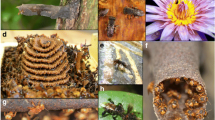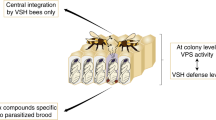Abstract
Species ofPsithyrus (Hymenoptera; Apidae) are obligate bumble bee social parasites. In this study, females ofP. vestalis andP. ashtoni were presented with pentane extracts prepared from different body parts of queens of their respective host species,Bombus terrestris andB. terricola. Parasites of both species were capable of distinguishing host bees from other bumble bee species using chemical cues contained within extracts. Among extracts of several body parts presented to parasites, the abdomen produced the greatest behavioral response, with Dufour's gland and terminal tergal segments eliciting the greatest response among abdominal regions. Extracts of these two body parts obtained fromB. terrestris queens shared a number of compounds, identified by GC-MS. Among the identified compounds are a number that have been reported to be of importance in bee sociochemistry.
Similar content being viewed by others
References
Blum, M.S. 1986. Specificity of pheromonal signals: a search for its recognitive bases in terms of a unified chemisociality, pp. 401–405,in J. Eder and H. Rembold (eds.). Chemistry and Biology of Social Insects. J. Perperny, Munich.
Bohart, G.E. 1970. The Evolution of Parasitism among Bees. Utah State University, 30 pp.
Cane, J.H., andMichener, C.D. 1983. Chemistry and function of manidibular gland products of bees of the genusExoneura (Hymenoptera, Anthophoridae).J. Chem. Ecol. 9:1525–1531.
Cederberg, B. 1979. Odour-guided host selection inPsithyrus (Hymenoptera, Apidae).Entomol. Tidskr. 100:128–129.
Cederberg, B. 1983. The role of trail pheromones in host selection byPsithyrus rupestris (Hymenoptera, Apidae).Ann. Entomol. Fenn. 49:11–16.
Cruz Landim, C. da 1963. Evolution of the wax and scent glands in the Apinae (Hymenoptera: Apidae).J. N.Y. Entomol. Soc. 81:2–13.
Cruz Landim, C. da, Dos Santos, S.M.F., andHöfling, M.C.A. 1980. Sex determination in bees. XV. Identification of queens ofMelipona quadrefafasciata anthidioides (Apidae) with the worker phenotype by a study of the tergal glands.Rev. Brazil Genet. III 3:295–302.
Duffield, R.M., Wheeler, J.W., andEickworth, G.C. 1984. Sociochemicals of bees, pp. 387–428,in W.J. Bell, and R.T. Cardé (eds). Chemical Ecology of Insects. Chapman and Hall, London.
Fisher, R.M. 1983. Recognition of host nest odor by the bumble bee social parasitePsithyrus ashtoni (Hymenoptera: Apidae).J. N.Y. Entomol. Soc. 91:503–507.
Fisher, R.M. 1985. Evolution and host specificity: Dichotomous invasion success of a bumble bee social parasite (Psithyrus citrinus) in colonies of its two hosts.Can. J. Zool. 63:976–981.
Franks, N., Blum, M., Smith, R.-K., andAllies, A.B. 1990. Behavior and chemical disguise of cuckoo antLeptothorax kutteri in relation to its hostLeptothorax acervorum.J. Chem. Ecol. 16(5):1431–1444.
Genin, E., Jullien, R., Perez, R., Fonta, C., andMasson, C. 1984. Donnees preliminaires sur les mediateurs chimiques du BourdonBombus hypnorum (Hymenoptere, Apoide, Bombinae).C.R. Acad. Sci. Paris Ser. III 299:297–302.
Hadley, N.F. 1980. Surface waxes and integumententary permeability.Am. Sci. 68:546–553.
Hefetz, A., Bergström, G. andTengö, J. 1986. Species, individual and kin specific blends in Dufour's gland secretions of halictine bees: Chemical evidence.J. Chem. Ecol. 12(1): 197–208.
Heller, S.R., andMilne, G.W.A. 1978. EPA/NIH Mass Spectral Data Base, Vols 1–5. National Standards Defence Data Service, National Bureau of Standards, Washington, D.C.
Howard, R.W., andBlomquist, G.J. 1982. Chemical ecology and biochemistry of insect hydrocarbons.Annu. Rev. Entomol. 27:149–172.
Howard, R.W., McDaniel, C.A., andBlomquist, G.J. 1980. Chemical mimicry as an integrating mechanism: Cuticular hydrocarbons of a termitophile and its host.Science 210:431–432.
Løken, A. 1984. Scandanavian species of the genusPsithyrus Lepeletier (Hymenoptera: Apidae)Entomol. Scand. Suppl. 23:1–45.
Nordlund, D.A. 1981. Semiochemicals: A review of the terminology, pp. 13–28,in D.A. Nordlund, R.L. Jones, and W. J. Lewis, (eds.). Semiochemicals: Their Role in Pest Control. John Wiley & Sons, New York.
Regnier, F.E., andWilson, E.O. 1968. The alarm-defence system of the antAcanthmyops claviger.J. Insect Physio. 14:955–970.
Smith, B.H. andRoubik, D.W. 1983. Mandibular glands of stingless bees (Hymenoptera: Apidae): Chemical analysis of their contents and biological function in two species ofMelipona.J. Chem. Ecol. 9:1465–1472.
Tengö, J. Hefetz, A., andFranke, W. 1990. Individual and group specific odours of bumble bee females, pp. 513–514, G.K. Veeresh, B. Mallik, and C.A. Viraktamath (eds.).in Social Insects and the Environment. Oxford & IBH Publishing Co., New Dehli.
Tengö, J., Hefetz, A., Bertsch, A., Schmitt, U., Luebke, G. andFranke, W. 1991. Species specificity and complexity of Dufour's gland secretion of bumble bees.Comp. Biochem. Physiol. B. 99B:641–646.
Vander Meer, R.K., andWojcik, D.P. 1982. Chemical mimicry in the myrmecopilous beetleMyrmecaphodius excavaticollis.Science 218:806–808.
Vander Meer, R.K., Saliwanchik, D., andLavine, B. 1989. Temporal changes in colony cuticular hydrocarbon patterns ofSolenopsis invicta: Implications for nestmate recognition.J. Chem. Ecol. 15(7):2115–2125.
Vinson, S.B. 1984. Parasitoid-host relationships, pp. 205–233,in W.J. Bell, and R.T. Cardé (eds.). Chemical Ecology of Insects. Chapman and Hall, London.
Wheeler, J.W., andDuffield, R.M. 1988. Pheromones of Hymenoptera and Isoptera, pp. 59–206,in E.D. Morgan and N.B. Mandava (eds.). C.R.C. Handbook of Natural Pesticides. Vol IV: Pheromones, Part B. CRC Press, Boca Raton, Florida.
Wilson, E.O. 1971. The Insect Societies. Harvard University Press, Cambridge, Massachusetts.
Wittmann, D., Lubke, G., andFranke, W. 1989. Cephalic volatiles identified in workers ofMourella caerulea, a rare stingless bee recently rediscovered in southern Brazil.Z. Naturforsch. 44C:325–326.
Author information
Authors and Affiliations
Rights and permissions
About this article
Cite this article
Fisher, R.M., Greenwood, D.R. & Shaw, G.J. Host recognition and the study of a chemical basis for attraction by cuckoo bumble bees (Hymenoptera: Apidae). J Chem Ecol 19, 771–786 (1993). https://doi.org/10.1007/BF00985008
Received:
Accepted:
Issue Date:
DOI: https://doi.org/10.1007/BF00985008




